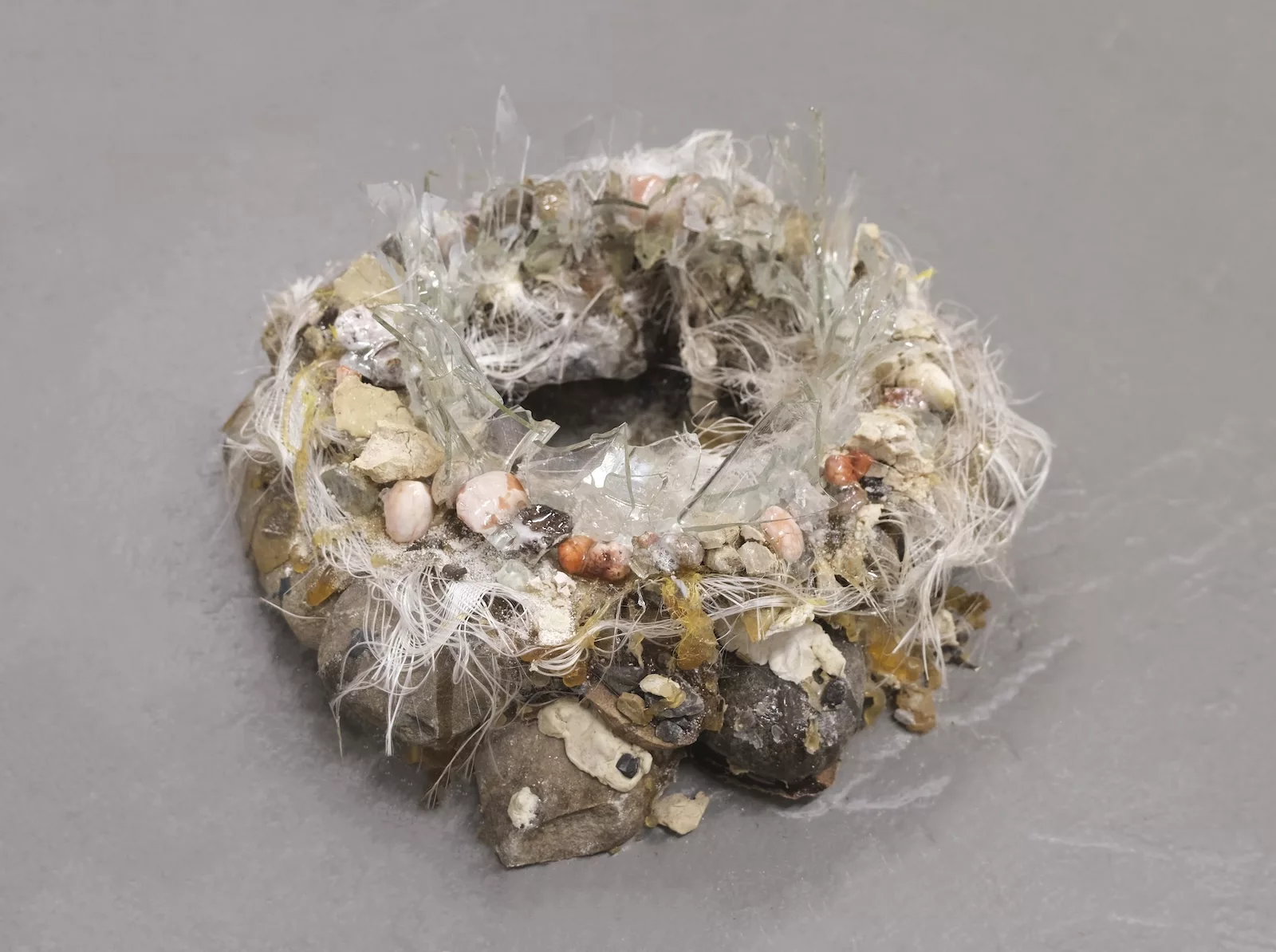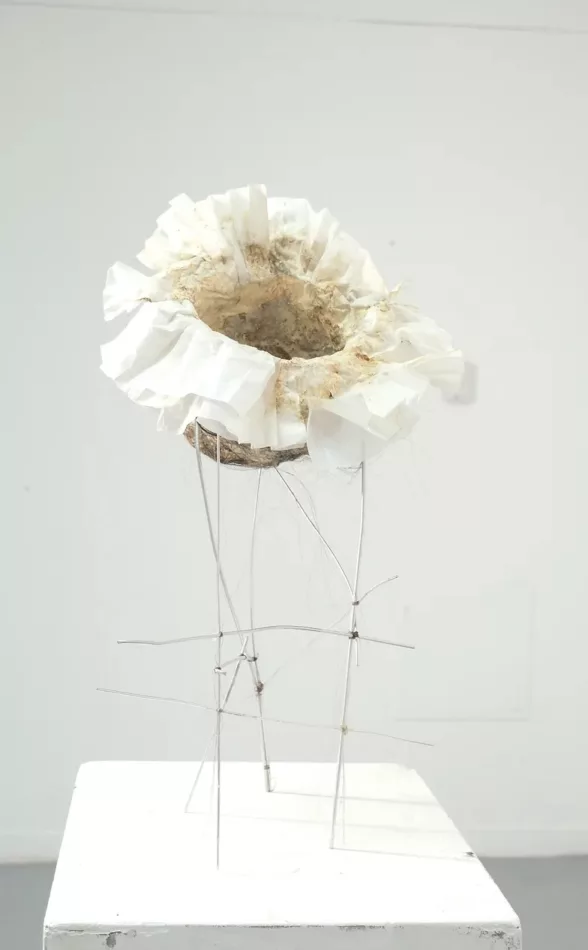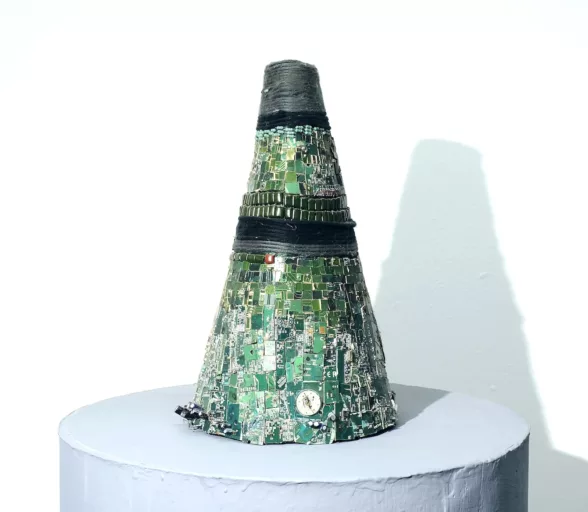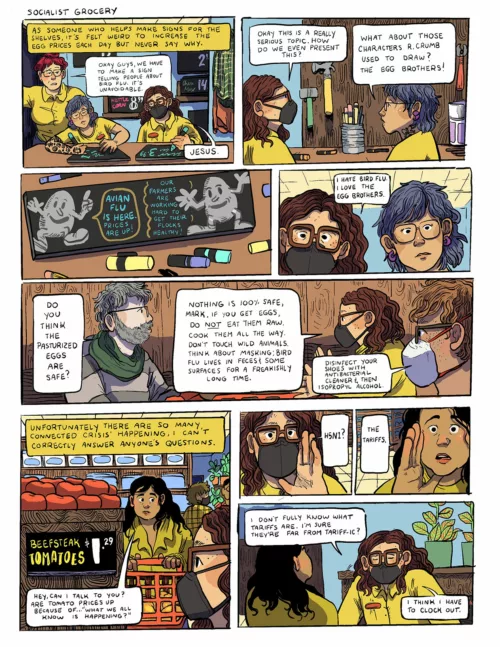
Introduction
Chenxi Shao (she/her/they/them) is a special artist who notices small things. They carefully consider and tinker until cautiously wondering if a piece is finished. They grow mushrooms over bandaids, and alter materials such as ceramics, glass, rocks, and paper mache, as well as found materials like circuit boards, gloves, tissue, and masks. Deeply intelligent and observant, the works hold a kind of head-tilted humor. And at the same time, an introspection and assessment of nature, the greater built environment, and cultural surroundings.
They are originally from Beijing, China, and are now based in Philadelphia following the completion of their MFA at the University of Pennsylvania. They also have a background in studying and practicing ecological research which comes through in the work, as well as their interest in identity, humanism, and environmental ethics. I met them when they joined Vox Populi Gallery last year, and have had the great pleasure of getting to know them since. This interview is from earlier in the year in preparation for a show I was curating, Transcendent Mess: to outwit representation (documentation of the exhibit). This interview was published previously in the catalog for the show. Readers can refer to the essay “Stop Making Sense” on Artblog for more information about the exhibition.
They welcomed me into their small Powelton Village apartment. We discussed their work and they served me hot tea out of a wine glass as we talked.
Chenxi Shao: When I make this piece, I’m just thinking of boundaries. I’m just thinking about how the silicone becomes to clay, become to ceramic, become to architectural material, and some modern material.
And I just want to visualize it in some kind of symbol like boundary. But I also want to give it a little bit of personality.
Lane Timothy Speidel: Yeah, like a dynamic boundary.
Chenxi: And then I feel it’s maybe a little bit too clear. So I make this one.
Lane: I don’t know why I want to take a bite out of it.
Chenxi: It would hurt a lot.
Lane: Yes. It feels like it would be crunchy to take a bite.
Chenxi: I’m very sensitive to this one. I was always obsessed with the sense of emerging and just at that time, I see a nest. And then I just think how this silicone thing developed from the rock to the glass. And this layer, this rock, actually they are the same as the bottom one, but the color looks more bright and colorful because I put them into the kiln. I use ceramic technology on them and I put them in the kiln and also I put a little bit glass glaze on the top of them.
This is glass. I just use some modern technology but on the original, ancient object. Because I think the rocks are just similar to the rocks 2,000 years ago.
Lane: Rocks are very old, right?
Chenxi: They’re very old. But ceramic clay is a more modern product. I just want to use this new technology with these old things to see how it looks. Because I am obsessed with that. I’m going to be talking about the primal aesthetics of the natural material. And also, I always want to give a sense that they grow upwards.
Because I’m a sensitive person, I always have a body perception of fragility and sensitivity and vulnerability. Sometimes I want my sculpture to give a response to my body’s perception. The specific body perception. So I just use this glass plate, use this sharp glass as a top. It’s also from my aesthetics, from plant or flower. Some flowers have a complex structure. They have a lot of petals.
Lane: (referring to an unfinished sculpture) That’s beautiful. I love it. So you said it’s not done?
Chenxi: That is not finished. I don’t think it can be finished because the idea is very young.
I just feel since the idea is young, no matter how I develop this thing, it cannot be finished. The whole structure. Because it’s too clear. I’m thinking of a boundary and then make a boundary. A beginning is okay.
But how could people think of boundaries as an artistic topic and then make a boundary?
But I also think without this, maybe I cannot have this, cannot have that.
Lane: Oh, I see. It’s because it progresses from one idea to the next idea.
Chenxi: Yeah. Maybe it’s not good enough, but it can inspire. It can keep me in the loop.

Chenxi: This is made of mushroom. They’re made of mushroom and they grow together.
I like material transformation. That the transformation can transform some body perception. Because, before that, I have vitiligo. Maybe that’s not obvious. My head has some white area.
Lane: Okay, I didn’t know that.
Chenxi: It’s not obvious. When this happened I feel something in my body. Like some disease or some uncomfortable feeling. Uncomfortable physical feeling or perception.
It embodies the mushrooms. This form itself is also like some feeling inside the body that is sprouting in our body. For me, maybe it’s inspired by this disease or this spread of color, but maybe for other people, there are also some other feelings from their body.
Or some other perception about their identity, or not.
It’s a hybrid of modern industrial product and natural networking, living lives. With body fabrication and motivation. So I feel it’s pointing to the dissolution of economic and environmental hierarchy.
It’s also from my, the sense of my body resistance. I also feel it’s like an allegory of continuing life in capitalist post-modern modernity and environmental issues. Mushrooms grow in the root of capitalism because capitalism causes a lot of deforestation.

Lane: And after the deforestation there’s a lot of mushrooms starting to grow and connect the roots, right?
Chenxi: It’s just a positive or negative form, and those negative forms also give an angle. Because when I grow this thing, the opening is just directly up. But when I show it… there’s an angle just like between the direction of our human conversation and the natural world. I want to give this ambiguity between these two angles.
I still reflect on the professor.
Lane: You’re the professor now.
Chenxi: I see, the subject of the exhibition is about transformation of material for some queer person.
Lane: Exactly. Exactly.
Chenxi: Nice. I’m good at it. I’m good at this.
Lane: I know.
Chenxi: I just put some everyday material on the top and the bottom and in the middle. (referring to a test where they experimented with growing mushrooms on different found objects) Because I want to test. I want to test if the mushroom can. And then I find that the mushroom can really grow through all the material. White cotton, brown paper, ear plug, paper receipt.
At the beginning they are clearly on the top of it. Here the process is just the mushroom growing around them and through them. And finally, I feel they can have the inclination to disappear. Not disappear, just buried.
About Chenxi Shao
Chenxi Shao (she/her/they/them) is an artist and designer originally from Beijing, China, now based in Philadelphia. Their work explores dynamic identity, humanism, and environmental ethics, bridging the realms of sculpture and animation.
With a background in ecological research, Chenxi integrates ecological concerns into their art, addressing pressing societal and environmental issues. Their contributions have been showcased at various venues including the Fringe Arts, Flux Factory, Galleries at Moore, Vox Populi Gallery, Yavapai College Art Gallery, Worthless Studios, Atelier, Galleries at Delaware County Community College, and Jianshexiang Gallery.
Chenxi holds degrees in Plant Genetics and Breeding (B.A.), Interface Ecology (Ph.D.), and an MFA from the University of Pennsylvania. Their remarkable accomplishments include receiving the Monument Lab MFA Fellowship at the Weitzman Center for Public Art and Space https://www.design.upenn.edu/cpas/home in 2023.





